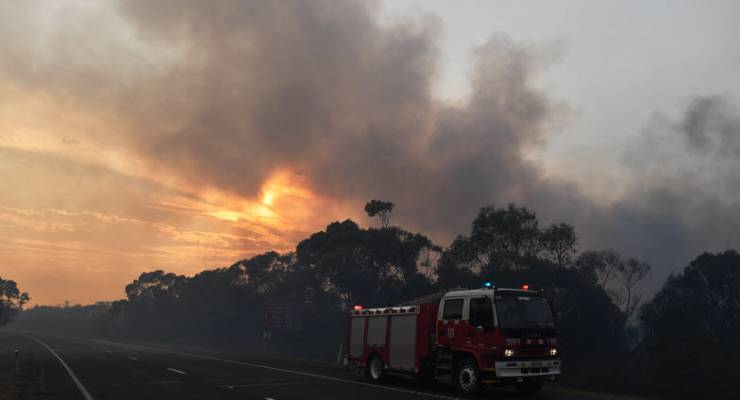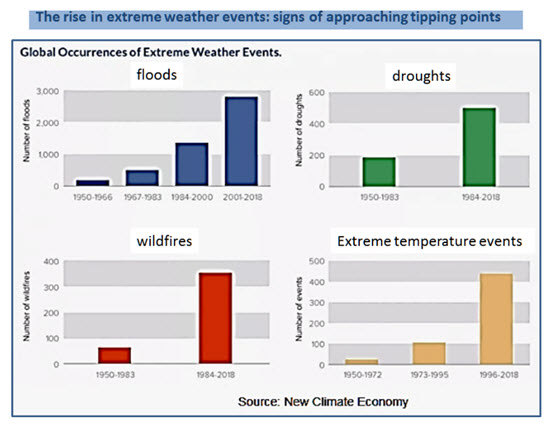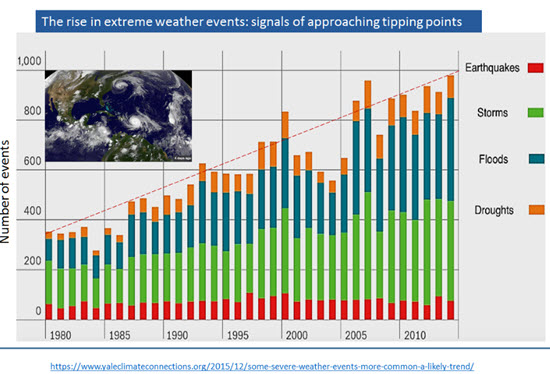
Dr Andrew Glikson is an Earth and paleo-climate scientist at the Australian National University’s Climate Change Institute. He has written exhaustively about climate change, the failures of policy in this area (and compliant dissemination of junk climate science through areas of politics and the media) which amount to, in his words, a “betrayal of the future“.
Crikey spoke with Glikson about the concrete changes we will see in Australia thanks to this betrayal, and the possibility of real action and hope in that context.
CRIKEY: What are the specific effects of climate change we are likely to see in Australia?
GLIKSON: There are several factors, depending on the time scale:
1. An increase in the magnitude and extent of wildfires. It takes only a spark, from lightning or human ignition, to start a fire. But it can involve high temperatures, a period of drought, a build-up of dry vegetation and strong winds to start a bushfire (such as has been devastating Queensland). When all these factors combine firestorms ensue, enhanced by strong winds from the hot interior of the continent, overwhelming the desiccated bush and human habitats. This is the face of global warming, which on the continents has reached an average of 1.5 degrees. Some 110 wildfires have raged across central Queensland. Large parts of the Australian continent may become uninhabitable due to bushfires.
2. Drought. An increasing incidence and scale of drought, such as the recent ongoing drought in Queensland and New South Wales and long-term rainfall decline. The past three years have seen the return of widespread rainfall deficiencies across southern and eastern Australia. Below-average rainfall across large parts of Australia since the end of the 2010 and 2011 La Niña events, and the failure of the northern wet season in much of inland Queensland over the past three years, have contributed to these deficiencies.
3. Sea level rise, in particular around low-lying Torres Strait Islands. Global sea levels are expected to increase by 45-82cm by 2090 for the high concentration scenario. These levels may be higher if a tipping point is reached which commits one or more land-based ice sheets to irreversible melting. Projected increases around Australia are very similar. Tropical regions suffer higher sea level rise. Around some islands sea level rise rates have reached 7-10 mm/year. Extreme high sea-level events will occur more frequently in future, increasing the risks of flooding and erosion in coastal areas. According to large groups of US scientists, the collapse of Greenland and west Antarctic ice sheets may raise sea levels on the scale of several metres. In line with global trends, sea waters around Australia are becoming more acidic, as the oceans absorb some of the CO2 released by human activities.
4. Tropical cyclones and storms. Trends in tropical cyclone activity in the Australian region (south of the equator) show that the total number of cyclones has decreased in recent decades, however the number of severe cyclones has increased.
5. Rain storms and flooding. On a meter or even larger scale, such as the floods in Townsville, with devastating consequences for urban and rural populations.
6. The demise of reefs, in particular the Great Barrier Reef. Since 1992, elevated sea temperatures induce a stress response of corals. Other factors include tropical cyclones, freshwater inflows and anthropogenic pollution, when combined leading to the demise of some 50% of the reef.
What kind of concrete day-to-day changes will this necessitate for the average person?
The risk and advent of fire, in particular in rural areas, requiring great effort in fire protection, rendering large areas uninhabitable. There will be major losses of crops and livestock, collapse of farms, bankruptcy of farmers and eventually food shortages. There will also be health effects such as heat stroke, and effects on transport and electricity systems.
How far along this process are we? How much, with the right kind of action, can be prevented, and how much is inevitable?
We are already feeling the effects of global warming, in particular through fires — this year and last year in Queensland and Tasmania and Victoria — and flooding — such as in Townsville and in Victoria.
Is there any cause for hope?
Humans need to make a choice — a choice between perpetual wars and destruction on the one hand, and protection of life on Earth on the other hand. As to optimism/pessimism, I think it is subjective and in the genes; some people remain optimistic regardless of the greatest dangers and some lose hope.
To what extent can recent extreme weather events in Australia (e.g. fires in Tasmania and Victoria, floods in Queensland) and environmental calamities (e.g. massive fish kills in the Murray Darling) be directly connected to the effects of climate change?
There is no question about this. Whereas any single event cannot be attributed to global climate change, the pattern is distinct. It shows a three-fold increase in the incidence of extreme weather events, as in the plot below:


Are there causes and effects associated with climate change that aren’t discussed enough, even amongst coverage of climate change that accepts the scientific consensus? What’s missing from most people’s understanding?
Most people underestimate the effects of climate change; it’s projected to reach three to four degrees later in the century, which is calamitous. Also, the rise in temperatures is unlikely to be linear but interrupted by transient freezing events, due to the weakening of the polar jet stream boundary, as happened in North America and Europe this year.
This piece is part of our dedicated climate change series, Slow Burn. Read the rest here.








“Most people underestimate the effects of climate change; it’s projected to reach three to four degrees later in the century, which is calamitous. And 5 degrees is projected to see the end of humanity in anythi g but small pockets, and 6 degrees means small numbers of hunter and collector societies, dispersed so far that they may never interact. All progress to date will see humanity go back thousands of years
Indeed DB !
Unless we seriously slow & reverse our consumption of finite resources and population growth.
I foresee a great employment opportunity, at least for a couple of generations after societal collapse, for scavengers able to loot the abandoned megapolises.
Pity most of them were based on being ports but, hey, wathca gunna do?
Bravo Andrew Glikson for such a comprehensive summary of what is already happening and what is likely to happen because of climate change. This, along with Ian Dunlop’s article yesterday in the Sydney Morning Herald (As an ex-coal boss, I’m telling politicians: wake up to climate threat https://www.smh.com.au/environment/climate-change/as-an-ex-coal-boss-i-m-telling-politicians-wake-up-to-climate-threat-20190313-p513qj.html) should be required reading for all politicians and candidates. Those who deny the reality of climate change must be rejected by the voters. This is an absolutely critical issue that overrides everything else.
Yes Australia needs a government that is going to manage the changes associated with climate change. So more hazard reduction burning, more feral animal control via game harvesting (so the control is on the correct side of the ledger as a profit centre), a plan for climate refugees coming by the tens of thousands (think Bangladesh no longer existing), underground water storage to capture more rainfall in a beneficial way, better housing and building design not so dependent on air conditioning, even changing the colour of bitumen from black to anything else, to name just a few things. The billion dollars the dolts in Canberra and George St have allocated to the insane Adani project would Be better spent on hydrogen and thorium R&D for base load power. All this against a background where Democracies around the world suffer from cash-for-policy syndrome. Perhaps the first step in managing CC is to abandon left vs right partisan politics and move to centrist vs everyone else. Hard right conservatives and luvvie left socialists can then be isolated and left behind.